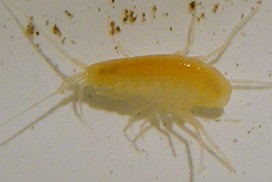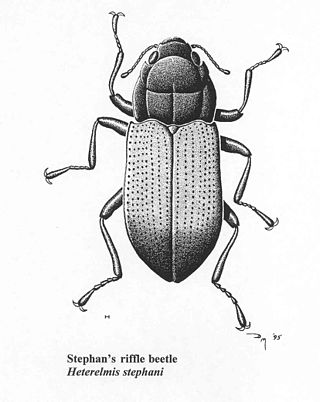
The Warner sucker is a rare species of freshwater ray-finned fish in the family Catostomidae. Native to Oregon in the United States and found only in the Warner Basin, its distribution extends just into Nevada and California. It is a federally listed threatened species. Its other common name is redhorse. The International Union for Conservation of Nature has rated this fish as an endangered species because of its small extent of occurrence, the small number of locations in which it is found, and the extreme fluctuations in area of occupancy resulting from drought and water abstraction. Conservation efforts have been put in place.

Allocrangonyx is a genus of troglobitic amphipod crustaceans from the South Central United States. The two species are both listed as vulnerable on the IUCN Red List. The animals are blind and unpigmented. During the male's development, the outer ramus of the third uropod differentiates into secondary segments and grows to a length greater than the animal's body length.
Lirceus usdagalun is a rare species of crustacean known by the common name Lee County cave isopod. It is endemic to Virginia in the United States, where it is known from a single network of karst cave systems in Lee County. It is threatened by a number of processes. It is a federally listed endangered species of the United States, and is assessed as "endangered" by the International Union for Conservation of Nature.

Stygobromus is a genus of amphipod crustaceans that live in subterranean habitats. The majority of the listed species are endemic to North America, a smaller number of species are also known from Eurasia. Most of the North American species live in areas which were not covered by the Laurentide Ice Sheet, although a few species seem to have survived under the ice. A number of species are on the IUCN Red List as endangered species (EN) or vulnerable species (VU); one species, S. lucifugus, is extinct.
Stygobromus balconis, the Balcones cave amphipod, is a troglomorphic species of amphipod in family Crangonyctidae. It is endemic to Texas in the United States.
Stygobromus flagellatus, commonly called Ezell's Cave amphipod, is a troglomorphic species of amphipod in family Crangonyctidae. It is endemic to Texas in the United States.
Stygobromus hayi is a rare species of crustacean known by the common name Hay's spring amphipod. It is endemic to the District of Columbia in the United States, where it occurs only in Rock Creek, a tributary of the Potomac River. It is a federally listed endangered species, is listed as Endangered on the IUCN Red List, and as Critically Imperiled by NatureServe.

Stygobromus pecki, the Peck's cave amphipod, is a rare species of crustacean found in four cavern areas of southwestern Texas in the United States. It is a federally listed endangered species in the United States and is also listed as Endangered on the IUCN Red List. Because of the species' limited geographical distribution, not much information on S. pecki is known. As of April 2022, there is no available 5-year review, Species Status Assessment, or recovery plan for the species. However, the Edwards' Aquifer Habitat Conservation Program (EAHCP), with the support of the U.S. Fish and Wildlife Service (UFWS), has been attempting to further study and promote conservation of S. pecki.
Stygobromus putealis, commonly called the Wisconsin well amphipod, is a phreatobite species of amphipod in family Crangonyctidae. It is endemic to Wisconsin in the United States.

Crangonyctidae is a family of cave-dwelling freshwater amphipod crustaceans. It contains the following genera:

Astragalus phoenix is a rare species of milkvetch known by the common name Ash Meadows milkvetch. It is endemic to Nye County, in southwestern Nevada.
Cyrtandra paliku is a rare species of flowering plant in the African violet family known by the common name cliffside cyrtandra. It is endemic to Hawaii, where it is known only from the island of Kauai. The plant was first discovered in 1993 and it was described to science as a new species in 2001. At the time it was discovered there was only one population containing 70 individuals; a 2006 count revealed only ten plants remaining. It was federally listed as an endangered species in 2010. Like other Hawaiian Cyrtandra it is called ha`iwale.
Stygobromus albapinus, the White Pine amphipod, is a troglomorphic species of amphipod in family Crangonyctidae. It is endemic to White Pine County, Nevada, where it occurs only in two pools in Model Cave in the Great Basin National Park.

Stygoparnus is a monotypic genus of beetles containing the single species Stygoparnus comalensis, which is known by the common name Comal Springs dryopid beetle. This rare beetle is endemic to Texas in the United States, where it is known from two springs. It is a federally listed endangered species of the United States.

Heterelmis comalensis is a rare species of beetle known by the common name Comal Springs riffle beetle. It is endemic to Texas in the United States, where it occurs in only two springs. It is a federally listed endangered species of the United States.

Heterelmis stephani was a rare species of aquatic beetle known by the common name Stephan's riffle beetle. It was endemic to Arizona in the United States, where it occurred in the Santa Rita Mountains before being declared presumed extinct. It was brown in color with small black dots on its wings.
Stygobromus russelli, known generally as the Russell stygobromid or Russell's cave amphipod, is a species of amphipod in the family Crangonyctidae. It is endemic to Texas in the United States.
David A. Hubbard, Jr is an American speleobiologist and karst geologist, exploring and documenting speological sites and life forms around Virginia and Maryland. He has published on phenomenon of burial caves, in particular by the indigenous peoples of Virginia, as well as the use of caves by human beings over the past 10,500 years.
Stygobromus canadensis, the Castleguard Cave stygobromid, is a species of amphipod in the Crangonyctidae family and Stygobromus genus. It is endemic to Castleguard Cave in Alberta, Canada. It was first described by John Holsinger in 1980. It is currently listed as critically imperiled by NatureServe.










